
Korean cuisine has evolved through centuries of social and political change. Originating from ancient agricultural and nomadic traditions in Korea and southern Manchuria, Korean cuisine reflects a complex interaction of the natural environment and different cultural trends.

A salad is a dish consisting of mixed ingredients, frequently vegetables. They are typically served chilled or at room temperature, though some can be served warm. Condiments and salad dressings, which exist in a variety of flavors, are often used to enhance a salad.

The radish is an edible root vegetable of the mustard family, Brassicaceae, that was domesticated in Asia prior to Roman times.

Kimchi is a traditional Korean banchan consisting of salted and fermented vegetables, most commonly using napa cabbage or Korean radish. A wide selection of seasonings are used, including gochugaru, spring onions, garlic, ginger, and jeotgal, etc. Kimchi is also used in a variety of soups and stews. Kimchi is a staple food in Korean cuisine and is eaten as a side dish with almost every Korean meal.

Daikon or mooli, Raphanus sativus var. longipinnatus, is a mild-flavored winter radish usually characterized by fast-growing leaves and a long, white, napiform root. Originally native to continental East Asia, daikon is harvested and consumed throughout the region, as well as in South Asia, and is available internationally. In some locations, daikon is planted for its ability to break up compacted soils and recover nutrients and is not harvested.

Greek salad or horiatiki salad is a popular salad in Greek cuisine generally made with pieces of tomatoes, cucumbers, onion, feta cheese, and olives and dressed with salt, Greek oregano, and olive oil. Common additions include green bell pepper slices or caper berries. Greek salad is often imagined as a farmer's breakfast or lunch, as its ingredients resemble those that a Greek farmer might have on hand.

Gimbap, also romanized as kimbap, is a Korean dish made from cooked rice, vegetables, fish, and meat rolled in gim—dried sheets of seaweed—and served in bite-sized slices. The origins of gimbap are debated. Some sources suggest it originates from Japanese norimaki, introduced during Japanese colonial rule, while others argue it is a modernized version of bokssam from the Joseon era. The dish is often part of a packed meal, or dosirak, to be eaten at picnics and outdoor events, and can serve as a light lunch along with danmuji and kimchi. It is a popular takeaway food in South Korea and abroad and is known as a convenient food because of its portability.
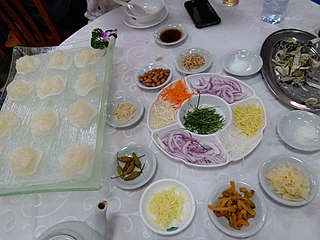
Yusheng, yee sang or yuu sahng, or Prosperity Toss, also known as lo sahng is a Cantonese-style raw fish salad. It usually consists of strips of raw fish, mixed with shredded vegetables and a variety of sauces and condiments, among other ingredients. There is also a vegetarian version of this dish, where the fish is replaced with soy "fish", which resembles salmon. Yusheng literally means "raw fish" but since "fish (魚)" is commonly conflated with its homophone "abundance (餘)", Yúshēng (魚生) is interpreted as a homophone for Yúshēng (餘升) meaning an increase in abundance. Therefore, yusheng is considered a symbol of abundance, prosperity and vigor.

Korean royal court cuisine was the style of cookery within Korean cuisine traditionally consumed at the court of the Joseon Dynasty, which ruled Korea from 1392 to 1910. There has been a revival of this cookery style in the 21st century. It is said that twelve dishes should be served along with rice and soup, with most dishes served in bangjja (bronzeware).

Okróshka is a cold soup of Russian origin, which probably originated in the Volga region.
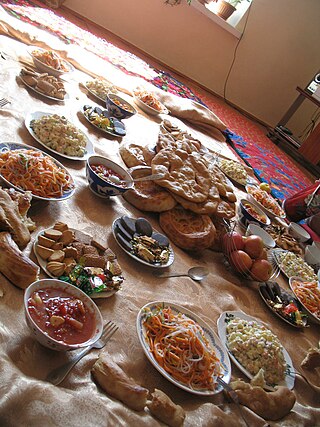
Central Asian cuisine has been influenced by Persian, Indian, Arab, Turkish, Chinese, Mongol, African, and Russian cultures, as well as the culinary traditions of other varied nomadic and sedentary civilizations. Contributing to the culinary diversity were the migrations of Uyghur, Slav, Korean, Tatar, Dungan and German people to the region.
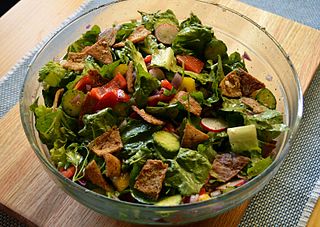
Fattoush is a Levantine salad made from toasted or fried pieces of khubz combined with mixed greens and other vegetables, such as radishes and tomatoes. Fattoush is popular among communities in the Levant.

Korean noodles are noodles or noodle dishes in Korean cuisine, and are collectively referred to as "guksu" in native Korean or "myeon" in hanja character. Preparations with noodles are relatively simple and dates back to around 6000 BCE to 5000 BCE in Asia. In Korea, traditional noodle dishes are onmyeon, called guksu jangguk, naengmyeon, bibim guksu, kalguksu, kongguksu among others. In royal court, baekmyeon consisting of buckwheat noodles and pheasant broth, was regarded as the top quality noodle dish. Naengmyeon, with a cold soup mixed with dongchimi and beef brisk broth, was eaten in court during summer.

Dongchimi is a variety of kimchi consisting of Korean radish, napa cabbage, scallions, pickled green chilli, ginger, Korean pear and watery brine in Korean cuisine. As the name dong and chimi, suggests, this kimchi is traditionally consumed during the winter season.
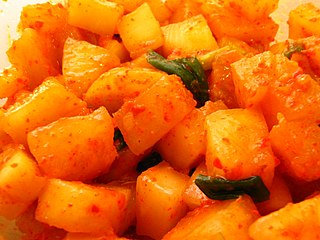
Kkakdugi (Korean: 깍두기) or diced radish kimchi is a variety of kimchi in Korean cuisine. Usually, Korean radish is used, but other vegetables or fruits can also be used. Kkakduk-kkakduk is an ideophone related to dicing/cubing. Kimchi made with radish that are not diced into cubes are not called kkakdugi. Kkakdugi is a popular banchan enjoyed by Koreans and others.

Pyeonyuk is a traditional Korean dish, which consists of thinly sliced meat that has been boiled and pressed. Either beef or pork may be used to make the dish.
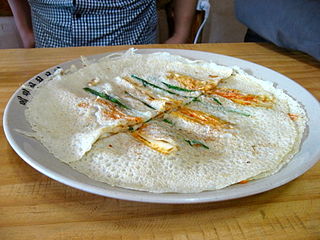
Memil-buchimgae (메밀부침개) or buckwheat pancake is a variety of buchimgae, or Korean pancake. It is a crepe-like dish made of thin buckwheat batter and napa cabbage.

Afghan salad is a salad in Afghan cuisine that is prepared with the primary ingredients of diced tomato, cucumber, onion, carrot, cilantro, mint and lime or sometimes lemon juice. Salt and pepper may be used to season the dish. Additional ingredients may be used, such as bell peppers, parsley, radish and herbs, among others.

Cheong is a name for various sweetened foods in the form of syrups, marmalades, and fruit preserves. In Korean cuisine, cheong is used as a tea base, as a honey-or-sugar-substitute in cooking, as a condiment, and also as an alternative medicine to treat the common cold and other minor illnesses.



















